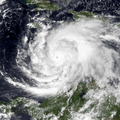2016 Atlantic hurricane season facts for kids
The 2016 Atlantic hurricane season was a very active period for storms in the Atlantic Ocean. It had more activity than usual, with many powerful storms forming in the northern part of the world. This season officially began on June 1st and ended on November 30th. During these months, tropical storms and hurricanes are most likely to form and grow.
What is a Hurricane Season?
A hurricane season is a special time of year when tropical storms are most likely to form. In the Atlantic Ocean, this period runs from June 1st to November 30th. During these months, the ocean waters are warm enough to create the energy needed for these big storms.
How We Measure Storms
Scientists use a few terms to describe how busy a hurricane season is:
- Named Storms: These are tropical storms that have winds strong enough to be given a name, like Hermine or Gaston.
- Hurricanes: These are even stronger storms. They have very fast winds that can cause a lot of damage.
- Major Hurricanes: These are the most powerful hurricanes. They are Category 3 or higher on the Saffir-Simpson Hurricane Wind Scale. They have extremely strong winds and can be very dangerous.
The 2016 season had 15 named storms, 7 hurricanes, and 4 major hurricanes. This was more than the average number of storms, making it an "above-average" season.
Images for kids
-
Hurricane Matthew near its secondary peak intensity northwest of Colombia on October 2
See also
 In Spanish: Temporada de huracanes en el Atlántico de 2016 para niños
In Spanish: Temporada de huracanes en el Atlántico de 2016 para niños




